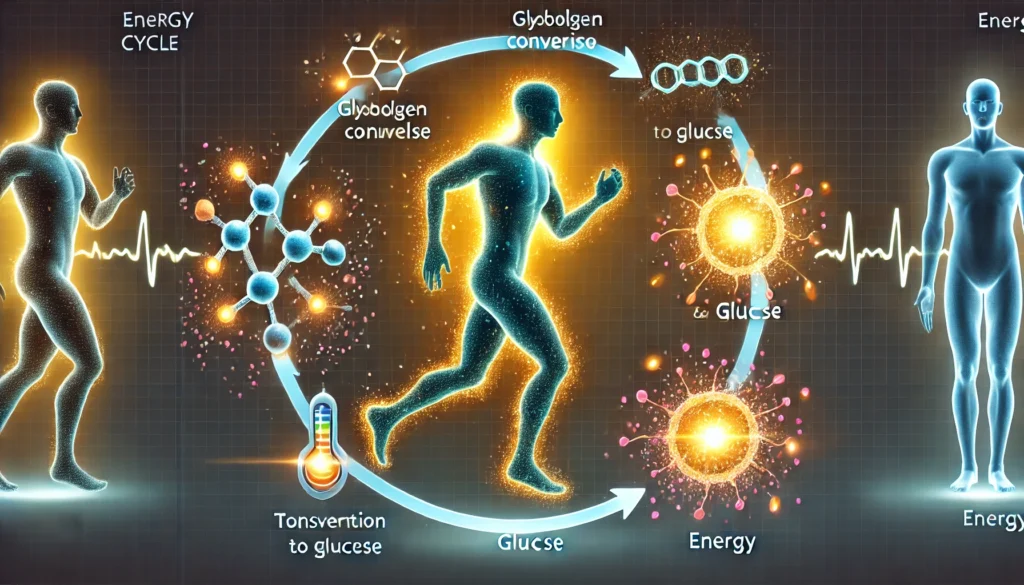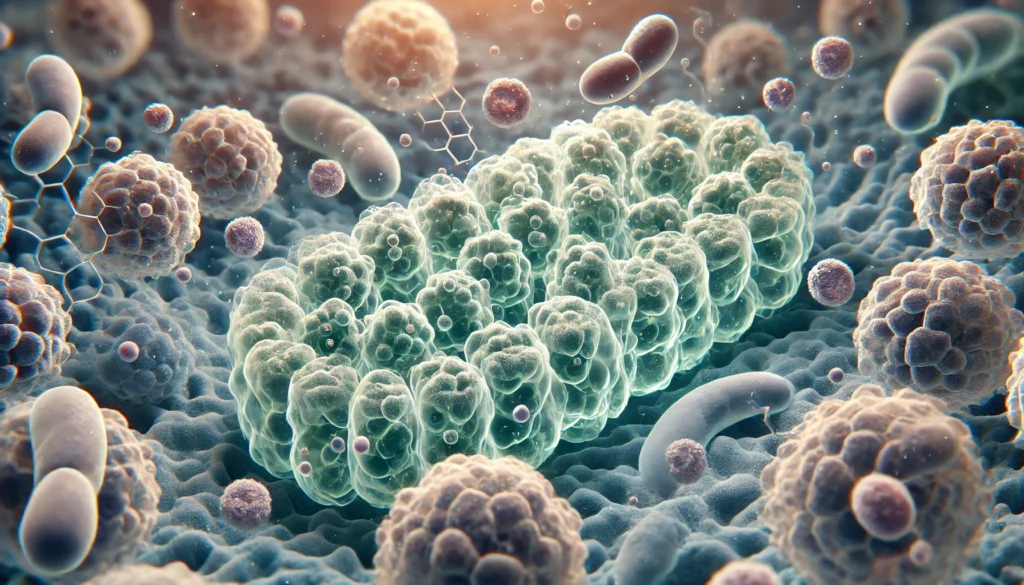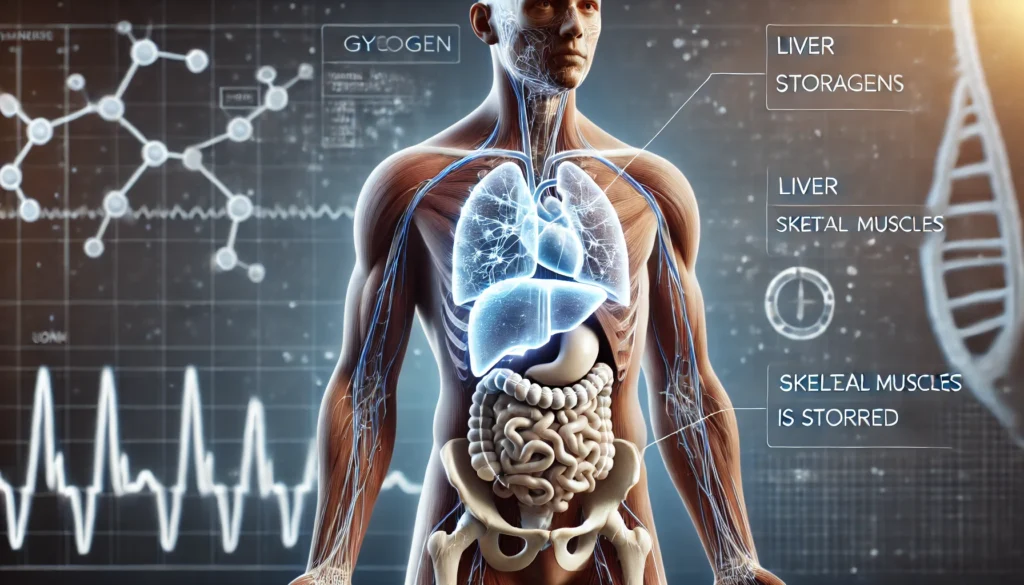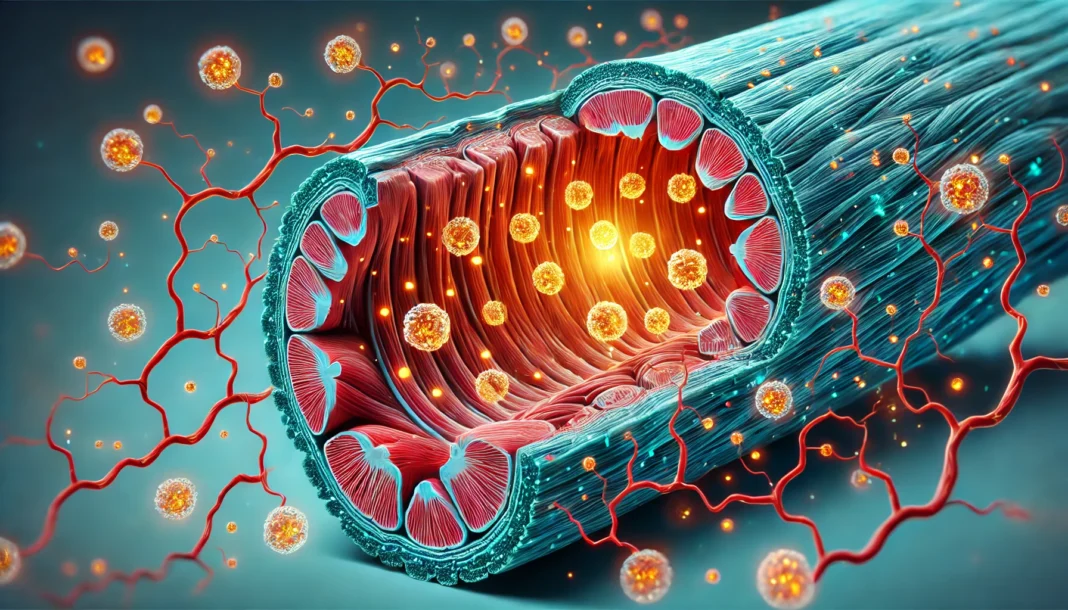Glycogen serves as the body’s primary stored form of glucose, functioning as a vital energy reserve that fuels various physiological processes. Composed of branched chains of glucose molecules, glycogen acts as a readily available energy source, particularly during periods of increased metabolic demand. Understanding glycogen’s role, storage locations, and metabolic functions is crucial for comprehending how the body manages energy balance and sustains essential functions. This article delves into the definition of glycogen, its storage sites, the biochemical processes that regulate its synthesis and breakdown, and its broader implications for health, exercise, and disease.
You may also like: How Diabetes Affects the Brain: Understanding Brain Fog, Memory Loss, and Mental Confusion from High Blood Sugar
Glycogen Definition: The Storage Form of Glucose
Glycogen is a complex polysaccharide composed of glucose units linked together primarily by alpha-1,4-glycosidic bonds, with branching points formed by alpha-1,6 linkages. This highly branched structure allows for rapid mobilization of glucose when the body requires energy. Glycogen synthesis occurs through a process known as glycogenesis, which is catalyzed by enzymes such as glycogen synthase. The stored glycogen in skeletal muscle and liver serves as a critical source of glucose, which is mobilized through glycogenolysis when energy demands rise. Unlike free glucose, which rapidly enters the bloodstream, glycogen provides a more stable and controlled energy source, preventing extreme fluctuations in blood sugar levels.

Where Is Glycogen Stored in the Body?
Glycogen is primarily stored in two main sites in the body: the liver and skeletal muscles. These storage locations serve distinct physiological purposes, ensuring that energy is available for both systemic and localized metabolic needs. The liver acts as the central glycogen reservoir, regulating blood glucose levels by releasing glucose into circulation when needed. In contrast, skeletal muscle glycogen remains within the muscle cells and is utilized locally to support contraction and movement during physical activity. The combined storage capacity of these two sites provides the body with a readily available energy reserve, essential for maintaining homeostasis and sustaining prolonged exertion.
Glycogen Storage in the Liver: The Central Energy Buffer
The liver serves as a primary site for glycogen storage, holding approximately 100 to 120 grams of glycogen under normal physiological conditions. Liver glycogen plays a crucial role in maintaining blood glucose levels, particularly during fasting states, sleep, and extended periods between meals. Hepatic glycogenolysis releases glucose into the bloodstream through the action of the enzyme glucose-6-phosphatase, which is absent in muscle cells. This process ensures a steady supply of glucose to the brain, red blood cells, and other tissues that rely on glucose as a primary energy source. Liver glycogen metabolism is tightly regulated by hormonal signals, including insulin and glucagon, which coordinate glucose storage and release in response to energy demands.
Glycogen Storage in Skeletal Muscle: Fueling Physical Activity
Skeletal muscle contains a larger total quantity of glycogen compared to the liver, typically storing between 300 to 500 grams, depending on factors such as fitness level, diet, and training status. Unlike liver glycogen, muscle glycogen is not directly available for systemic glucose regulation, as muscle cells lack glucose-6-phosphatase. Instead, stored glycogen in skeletal muscle serves as an immediate energy source for muscle contraction during physical activity. The breakdown of muscle glycogen through glycogenolysis generates glucose-6-phosphate, which enters glycolysis to produce ATP, the energy currency of the cell. This localized energy provision is particularly critical during high-intensity exercise, endurance training, and resistance workouts.
How Are Excess Sugars Stored in the Body?
Excess dietary glucose that is not immediately used for energy production is stored in the body through glycogenesis. This process converts glucose into glycogen, which is stored predominantly in the liver and skeletal muscles. However, the body’s glycogen storage capacity is finite, and once these reserves reach their maximum limits, additional glucose is converted into fatty acids through lipogenesis. These fatty acids are then stored in adipose tissue as triglycerides, representing a long-term energy reserve. The body’s ability to efficiently switch between glycogen storage and fat storage is essential for metabolic flexibility and overall energy balance.
The Role of Glycogen in Exercise and Performance
Glycogen function is particularly relevant in the context of exercise, where energy demands increase significantly. Athletes and physically active individuals rely on stored glycogen in skeletal muscle to sustain performance and delay the onset of fatigue. The depletion of muscle glycogen stores is a key factor contributing to endurance limitations, commonly referred to as hitting the “wall” in endurance sports. Carbohydrate loading, a nutritional strategy used by athletes, aims to maximize muscle glycogen stores before competition, thereby enhancing performance and delaying fatigue. Post-exercise glycogen replenishment is equally important, as glycogen resynthesis allows for recovery and prepares the muscles for subsequent bouts of physical activity.
Glycogen Metabolism and Blood Sugar Regulation
The dynamic balance between glycogen synthesis and breakdown is integral to maintaining stable blood glucose levels. The pancreas plays a central role in regulating this balance by secreting insulin and glucagon in response to blood sugar fluctuations. Insulin stimulates glycogenesis by promoting glucose uptake into liver and muscle cells, where it is converted into glycogen for storage. Conversely, glucagon triggers glycogenolysis, releasing glucose from liver glycogen stores to prevent hypoglycemia. This intricate regulatory system ensures that the body maintains an adequate supply of glucose for metabolic needs without excessive fluctuations.
Can Glycogen Be Stored Anywhere Else in the Body?
While the liver and skeletal muscle serve as the primary sites for glycogen storage, small amounts of glycogen are also present in other tissues, including the brain, kidneys, and adipose tissue. These secondary storage sites contribute minimally to overall glycogen reserves but may play specialized roles in local energy metabolism. For instance, astrocytes in the brain store limited glycogen, which can be mobilized to support neuronal function under conditions of glucose scarcity. Similarly, glycogen in the kidneys and adipose tissue may serve as a supplementary energy source for cellular processes in these tissues.

Frequently Asked Questions: Understanding Glycogen and Blood Sugar Regulation
1. How do psychological stress and cortisol levels impact glycogen storage and glucose regulation?
Chronic stress can significantly alter the way the body handles glucose and glycogen. Elevated cortisol levels, a common response to long-term stress, stimulate gluconeogenesis and hinder glycogen synthesis. This disrupts how excess sugars are stored in the body, skewing the balance between the two main sites for glycogen storage in the body—skeletal muscle and liver. Cortisol also reduces insulin sensitivity, impairing how you convert blood sugar into energy and decreasing the efficiency of stored glycogen in skeletal muscle. Over time, this can lead to abnormal glucose levels, even if your diet is healthy. Understanding what glycogen does during stress helps contextualize why managing stress is vital for metabolic health.
2. What are the implications of intermittent fasting on glycogen metabolism and energy availability?
Intermittent fasting alters how glycogen is used and replenished. During fasting periods, the body first depletes liver glycogen—the most accessible glycogen storage—before breaking down fat or muscle for energy. This demonstrates what glycogen does in your body as an energy bridge between fed and fasted states. While fasting helps some people improve metabolic flexibility, it can limit stored glycogen in skeletal muscle if not enough carbohydrates are consumed during eating windows. Additionally, how are excess sugars stored in the body changes during refeeding periods, often prioritizing liver over muscle depending on energy needs. Understanding glycogen function in fasting protocols can help you avoid fatigue and optimize athletic performance.
3. Can glycogen storage be influenced by gender or hormonal fluctuations?
Yes, gender and hormones influence where glycogen is stored and how efficiently it’s replenished. Women tend to rely more on fat oxidation than glycogen during endurance activities, potentially conserving more stored glycogen in skeletal muscle. Estrogen appears to enhance lipid metabolism while reducing carbohydrate dependence, thereby altering how excess sugars are stored in the body. In contrast, testosterone may increase muscle glycogen synthesis post-exercise, making glycogen storage more efficient in males. These hormonal differences not only affect glycogen definition in physiological terms but also impact athletic performance, recovery, and nutritional needs based on sex. It’s essential to describe glycogen for the body in a gender-specific context when crafting dietary or training regimens.
4. How does sleep quality affect glucose storage and glycogen replenishment?
Sleep is a critical regulator of blood sugar control and glycogen replenishment. Poor sleep decreases insulin sensitivity, impairing how is extra sugars in the body stored during rest periods. Additionally, inadequate sleep reduces growth hormone secretion, which affects muscle repair and glycogen storage where it’s most needed—especially in skeletal muscle. When sleep is disrupted, your ability to convert blood sugar into energy becomes inefficient, leading to more circulating glucose and less replenished glycogen glycogen reserves. Over time, this can impact both liver and muscle, the 2 main sites for glycogen storage in the body. For optimal energy metabolism, improving sleep hygiene should be prioritized alongside nutrition and exercise.
5. Is glycogen exclusively stored in the liver and muscles, or can glycogen be stored anywhere else in the body?
While the liver and skeletal muscles are the primary storage sites, trace amounts of glycogen can also be found in other tissues. For example, astrocytes in the brain store small amounts of glycogen, supporting neurological function during glucose deficits. This rarely mentioned fact expands the answer to “can glycogen be stored anywhere else?” and highlights the complex nature of glycogen function beyond just energy storage. However, this nontraditional storage is minimal and doesn’t replace the dominant roles of the liver and muscle, which are the answer to “what do muscles and the liver store” in the context of glucose metabolism. This also enhances our understanding of glycogen simple meaning biology by recognizing its presence in specialized tissues.
6. How do different types of physical activity affect glycogen storage capacity in muscles?
The type, intensity, and duration of exercise determine how much glycogen can be stored and where glycogen is stored in the body. Endurance training increases the capacity for stored glycogen in skeletal muscle, improving fatigue resistance. Strength training, while primarily anaerobic, also promotes glycogen storage through muscle hypertrophy. Understanding what makes glycogen in muscles more efficient is crucial for athletes—both aerobic and anaerobic activities enhance how are excess sugars stored as glycogen, especially when coupled with post-workout nutrition. This process reaffirms glycogen’s role as the storage form of glucose and enhances our practical grasp of glycogen function in varied fitness routines.
7. What is the role of glycogen during illness or infection, and why does it matter?
During illness, your body consumes more energy to fight infection, rapidly tapping into stored glycogen in skeletal muscle and the liver. This highlights why understanding where glycogen is located becomes vital during periods of physiological stress. Fever, inflammation, and immune activity increase glucose demand, and without adequate reserves, the body may begin breaking down muscle tissue. In this state, how are excess sugars stored in the body shifts toward supporting immune function over long-term energy storage. The glycogen definition extends here to include its immunological role, revealing that glycogen glycogen isn’t just fuel for movement—it’s also vital for recovery and healing.
8. How does aging affect glycogen metabolism and glucose regulation?
Aging affects the efficiency of glucose storage and glycogen synthesis, often diminishing where is glycogen stored in the body. As muscle mass naturally declines (a process called sarcopenia), the ability to maintain high levels of stored glycogen in skeletal muscle also decreases. Simultaneously, insulin resistance may develop, compromising how is extra sugars in the body stored and increasing the risk of type 2 diabetes. This makes the question of what does glucose and glycogen do in your body especially relevant for older adults, whose metabolic flexibility becomes more limited. Optimizing protein intake, resistance training, and sleep can partially reverse these age-related changes and improve glycogen function over time.
9. How do high-fat or ketogenic diets influence glycogen levels and glucose usage?
Low-carbohydrate diets like keto reduce glycogen levels since carbohydrates are limited. This alters the usual process of how do you convert blood sugar into energy—fat becomes the primary fuel, and glycogen stores are preserved but not maximized. While keto may improve fat oxidation and weight loss, it limits how excess sugars are stored as glycogen, especially in muscle. In this context, glycogen mean something different functionally: a backup fuel source rather than a primary one. Still, for athletes or active individuals, reduced glycogen storage where it matters most—skeletal muscle and liver—can hinder high-intensity performance, raising concerns about long-term metabolic flexibility.
10. What emerging research is revealing new insights into glycogen synthesis and storage?
Recent research is examining the molecular regulators of glycogen synthesis, including enzymes like glycogen synthase and their role in controlling how excess sugars are stored in the body. Scientists are also exploring how gut microbiota may indirectly influence glycogen metabolism, offering a potential link between digestive health and how do you convert blood sugar into energy. Advances in wearable glucose sensors are improving real-time understanding of glycogen function in athletes and diabetics alike. These insights are refining our understanding of what is glycogen made of, beyond just glucose units—it’s a dynamic, enzyme-regulated system influenced by diet, activity, and even microbial interactions. Such findings are reshaping how we describe glucose and glycogen for the body in future health and nutrition strategies.

Conclusion: The Significance of Glycogen in Energy Balance and Health
Glycogen plays a pivotal role in energy metabolism, serving as a readily accessible storage form of glucose that supports both systemic and localized energy demands. Understanding glycogen’s function, storage locations, and metabolic regulation provides valuable insights into how the body maintains energy balance, sustains physical performance, and adapts to varying nutritional states. By optimizing glycogen storage through diet and exercise, individuals can enhance their metabolic flexibility, improve athletic performance, and support overall health. The intricate interplay between glycogen metabolism, hormonal regulation, and energy expenditure underscores the complexity of the body’s energy management system, highlighting the importance of glycogen as a key component of metabolic health.
glycogen metabolism, liver glycogen function, muscle glycogen storage, energy balance and glycogen, glycogen breakdown process, glucose storage in body, glycogen vs fat storage, insulin and glycogen regulation, glycogen resynthesis after exercise, carbohydrate metabolism in body, glucose and energy production, endurance exercise glycogen, glycogen depletion in athletes, metabolic role of glycogen, blood sugar control mechanisms, dietary impact on glycogen storage, muscle energy reserves, glycogen synthesis pathways, glycogen loading strategies, impact of fasting on glycogen
Further Reading:
Disclaimer: The content published on Better Nutrition News (https://betternutritionnews.com) is for informational and educational purposes only. It is not intended as a substitute for professional medical advice, diagnosis, or treatment. Always seek the guidance of a qualified healthcare professional before making any changes to your diet, nutrition, or wellness practices. The opinions expressed by authors and contributors are their own and do not necessarily reflect those of Better Nutrition News.
Better Nutrition News and its affiliates make no representations or warranties regarding the accuracy, completeness, or reliability of the information provided. We disclaim all liability for any loss, injury, or damage resulting from the use or reliance on the content published on this site. External links are provided for reference purposes only and do not imply endorsement.



